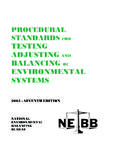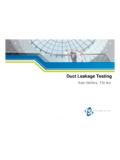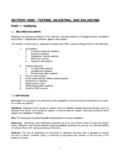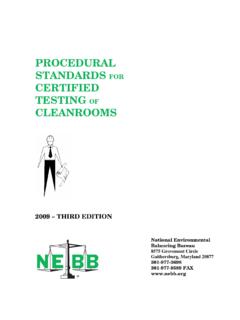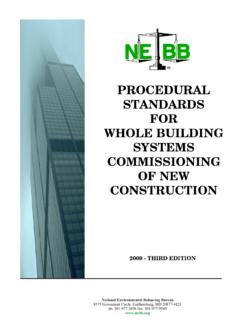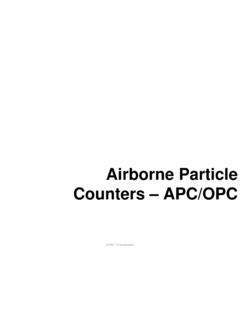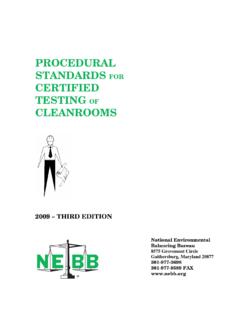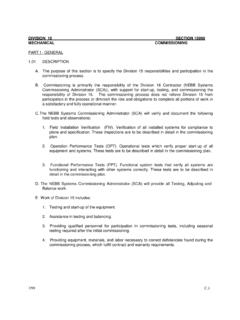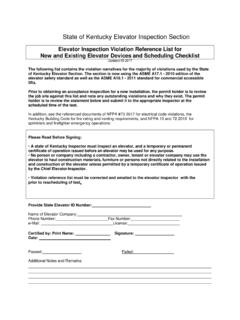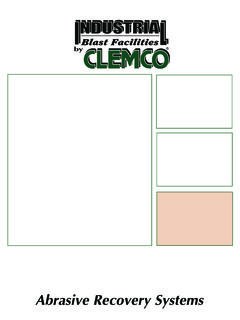Transcription of THE BASICS OF ROOM AIR DISTRIBUTION - NEBB
1 THE BASICS OF room AIR DISTRIBUTIONDan Int-HoutChief Engineer / KruegerRichardson Texas3/22/2011 Why Air DISTRIBUTION ? What are we trying to accomplish with air DISTRIBUTION system? Provide Occupant Thermal Comfort Provide sufficient ventilation to meet codes Control Latent loads (Humidity)What supplies the air we are Distributing? Most systems provide air from overhead and attempt to provide well mixed spaces. Sources include rooftops, VAV, WSHP, Chilled beams, etc Some systems are partially or fully stratified. Lets start by understanding basic terminology:Understanding The TerminologyPrimary Air Jets-Air jets from free round openings, grilles, perforated panels, ceiling diffusers and other outlets can be defined by three variables.
2 Throw Drop SpreadUnderstanding The TerminologyTHROWDROPU nderstanding The Terminology50 fpmTypical 100 fpm150 - is defined as the divergence of the airstream in a horizontal or vertical plane after it leaves the outlet. UnderstandingThe TerminologyCoandaEffectCoandaEffect - a negative or low pressure area is created between the moving air mass and the ceiling at or near the supply air outlet. This low pressure area causes the moving air mass to cling to and flow close to the ceiling surface and increases the throw. Understanding The TerminologyUnderstanding primary air jetvariables enables Accurate prediction of room air flow Improvement of thermal comfort Proper selection of grilles, registers and diffusers Adherence with ASHRAE Ventilation Std is a LeedPREREQUISITE,and is required by many The TerminologyThe Basis of Catalog Performance Data Throw The horizontal or vertical axial distance an airstream travels after leaving an air outlet.
3 Usually assumes a surface adjacent to the air outlet Pressure Can be total pressure or static pressure Sound Can be either NC or Octave Band dataThrow Throws are cataloged for 150, 100 and 50 fpm terminal velocities. Throws should be selected so that jets do not collide, but have sufficient projection for the area to be 8 12150fpm100fpm50fpmPressurePressure Air outlet pressure data is required to properly size the air delivery system within a building. Static Pressure The outward force of air within a duct, measured in inches of water column. Velocity Pressure The forward moving force of air within a duct, measured in inches of water column.
4 Total Pressure The sum of the velocity and static pressures, expressed in inches of water column and can be obtained by use of a PV+ PSPTPSPSPTS oundSound levels reported for diffusers are conducted in accordance with ASHRAE Standard 70. Catalog sound data assumes 10 diameters of straight duct. room absorption is assumed to be 10dB in all bands. In practice however, room sound levels are probably 5 NC higher than Air DistributionInductive Air DISTRIBUTION --Laminar and Radial Flow Laminar and Radial Flow OutletsOutlets Hospital Operating Suites Hi-Tech Electronics and other industrial applications Clean Rooms LaboratoriesLaminar Flow Radial FlowPressurized plenum for coreDucted perimeter with fan powered boxes, or other techniques, depending on climate, glass load, : Underfloor Air DistributionUFAD.
5 Underfloor Air DISTRIBUTION A raised floor allows electrical and communication circuits to be easily accessed and changed. Air may be distributed within this space, without Outlet Selection Interior Outlet Selection 1/workstation1/workstationUFAD Perimeter Outlet SelectionUFAD Perimeter Outlet Selection Perimeter solutions vary considerably Avoid condensing coils under the floor Hydronic coils often leak Exhaust at the perimeter to draw heat away Best solutions seem to be heat and cool from overhead17 Displacement SystemsDisplacement Systems To be addedSelect based on adjacent zone ApplicationsClassrooms KitchenRestaurantAuditoriumsAtriumsGymsA nd Mixed-High Induction Diffusers Commercial Office
6 Spaces High Velocity Jets Long Throw Designed to Mix in ZonePLQ-R1400 PrismAir DISTRIBUTION , Poor PatternAir DISTRIBUTION , Poor PatternTHERMOSTATPOORLY ADJUSTED / SELECTED DIFFUSERPROPERLY ADJUSTED/SELECTED DIFFUSERTHERMOSTATAir DISTRIBUTION , Good PatternAir DISTRIBUTION , Good PatternThermal ComfortASHRAE Standard 55-2010 mandates a maximum F vertical temperature stratification in Occupied Zone2 2 Floor to Occupants Head Level( ft. for seated, 6 ft. for standing occupants)Velocities within the occupied zone shall be 50 FPMV elocities within the occupied zone shall be 50 FPMU nderstanding ADPIADPI ADPI is the percentage of points within the occupied zone having a range of effective draft temperatures of -3 to +2 of average room temperature at a coincident air velocity less than 70 FPM.
7 ADPI is essentially a measure of the degree of mixing in zones served by overhead cooling systems. When air DISTRIBUTION is designed with a minimum ADPI of 80% the probability of vertical temperature stratification or horizontal temperature non-uniformity is low and conformance with ASHRAE Standard 55 (Thermal Comfort) requirements is high. ADPI does not apply to heating situations or ventilation-related mixing. ADPI selection using T50/ L was developed in the 60s where L is the distance to the nearest wall or halfway to the nearest air A relationship was found between 50 FPM/min isothermal throw and cooling throw, Using this table engineers can assure clients that diffuser selections will provide acceptable mixing and air change Fundamentals Chapter 20, Table 3 Perforated 24X24, 10 inlet, 4 way, 20 Unit Separation Distance420350300250160 RangeSpacing for 80% ADPINC=35 CFMP rism Unit Separation Distance, L60054543627310910in.
8 NeckNC=37 Prism, 24 x24 , 10 inlet, 20 TSpacing for 80% ADPIRoom Air SpeedRoom Air SpeedIssues and FactorsIssues and Factors Standard 55 says thermal comfort can be achieved with 0 fpm air motion. Uniform air temperatures indicate good mixing when loads are present. With conventional (well-mixed) systems, room air speed is driven primarily by room loads when air supply is below CFM/sq. ft. and air diffusion is adequate per ASHRAE sponsored research Partitions can provide excellent comfort with ceiling diffusers when & ASHRAE Code LEED & ASHRAE Code ComplianceCompliance In LEED 2009, in order to get ANY LEED points, one must fully meet the Ventilation Rate Procedure calculation in ASHRAE Standards (Ventilation) ASHRAE VRP requires that if heating air supplied from the ceiling is less than 15 above room temperature but does not reach within feet of the floor at 150 FPM the outdoor air supply must be increased by 25%.
9 ASHRAE VRP requires that if the heating air supplied from the ceiling is greater than 15 above room temperature the outdoor air supply must also be increased by 25%. LEED 2009 Ventilation points are gained by increased ventilation 30% beyond minimums. Non Typical Throw AnalysisSpecial Applications High bay application - Ceilings over 12 high Heating is a challenge due to buoyancy. Take advantage of vertical stratification where possible Required Heating airflow rate may exceed cooling airflow rate. Keep heating supply air temperature to room temperature T to a minimum If supplying air DISTRIBUTION from the ceiling, consider using round diffusers, drum louvers, or diffusers with some vertical projection.
10 One cannot use ADPI to predict heating performance. Consider Displacement Ventilation for cooling applicationsDiffuser Selection & Buoyancy ADPI isn t always the best way to analyze, select and place diffusers, especially with heating and high bay applications. One can estimate Throw as a function of T and buoyancy. Simple rule: Distance to 75ft/min is affected by 1%/degree(F) :1. 20 T Cooling, Vertical Down = +20% projection2. 20 T Heating, Vertical Down = -20% projection3. 20 T Heating, Along Ceiling = +20% projection Side Wall Register Selection & Buoyancy Horizontal free jet: Vertical change @ 75ft/min is affected by 1% of 75fpm throw/F0 : 15oF Delta T heating15% T75 Note: T150is not affected by Delta-tEntrained vs.
